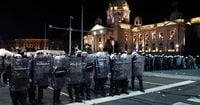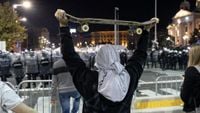On Sunday, November 2, 2025, the usually bustling heart of Belgrade became the stage for a dramatic confrontation between rival groups, as hundreds of riot police moved in to separate opponents and loyalists of Serbia’s President Aleksandar Vucic. The city’s political temperature, already high after a year of persistent anti-government protests, reached a boiling point in the shadow of recent tragedy and mounting calls for change.
According to the Associated Press and other international sources, several thousand people gathered on both sides of heavy police cordons in central Belgrade. Officers in full riot gear formed multiple rows between the crowds, who hurled bottles, flares, and even stun grenades at one another. The tense standoff unfolded just a day after tens of thousands had rallied in Novi Sad, Serbia’s second-largest city, to mark the somber first anniversary of a train station disaster that killed 16 and ignited a youth-led movement demanding sweeping political changes.
The Novi Sad tragedy, which occurred on November 1, 2024, has become a lightning rod for public anger and grief. Many protesters accuse the government of corruption and nepotism, alleging that shoddy renovation work and disregard for safety rules led to the deadly collapse of a concrete canopy. For the families of the victims, the wounds remain raw—and the search for accountability has become a rallying cry.
One of the most poignant figures to emerge from this movement is Dijana Hrka, mother of Stefan Hrka, who lost his life in the Novi Sad disaster. On Sunday, Hrka announced she was launching a hunger strike near a tent camp outside the Serbian parliament, a site that has been occupied by Vucic’s loyalists since March. Her demands are clear: justice for her son and the other 15 victims, the release of detained protesters, and the scheduling of early parliamentary elections—echoing the demands of university students who have been at the forefront of recent demonstrations.
Support for Hrka quickly spread. Protesters gathered not only in Belgrade, but also in Novi Sad and smaller towns, standing in solidarity with her call for accountability and change. The mood among anti-government demonstrators was one of determination, but also of frustration at what they see as an entrenched and increasingly authoritarian regime. As reported by multiple outlets, the rally in Novi Sad on Saturday was not just a commemoration—it was a public display of deep discontent with President Vucic’s 13-year rule.
The government, however, has presented a very different narrative. Both police and President Vucic himself accused anti-government protesters of attacking the loyalists’ camp, which Vucic described as a “symbol of freedom.” Protesters countered that most of the violent incidents originated from within the camp, further fueling mutual distrust and suspicion. The enclosed zone, colloquially known as “Caciland,” was established by Vucic’s supporters ahead of a major rally in March 2025. Filling a park and a street between the president’s office and parliament, “Caciland” has been heavily guarded by police and closed off to ordinary Belgrade residents, creating what some see as a fortress-like buffer for the president.
The atmosphere around “Caciland” has been tense for months. A shooting incident at the camp in October 2025 only heightened fears that the political standoff could spiral into violence. Authorities have responded to the protests with a firm hand: hundreds of demonstrators have been detained in recent months, and police have repeatedly broken up rallies. Pro-government media and officials have gone so far as to brand protesting university students as “terrorists,” accusing them of inciting violence and threatening public order.
The government’s crackdown has drawn sharp criticism from opposition groups and human rights advocates, who argue that the labeling of peaceful protesters as “terrorists” is an attempt to delegitimize dissent and stifle democratic debate. Yet President Vucic’s supporters see the loyalists’ camp as a necessary safeguard against what they describe as provocations and threats from the opposition. The camp, in their view, represents a bulwark of stability at a time of national uncertainty.
For many in Serbia, the events of the past year have laid bare a society deeply divided—not just over the legacy of the Novi Sad tragedy, but over the very future of the country’s political system. Youth-led protesters have become a powerful force, demanding not only justice for the victims but also an end to what they see as a culture of impunity and corruption at the highest levels of government. Their calls for early elections are rooted in a belief that only sweeping political change can restore public trust and prevent future disasters.
At the same time, President Vucic’s loyalists remain fiercely committed to defending his administration, arguing that the opposition is exploiting tragedy for political gain. The physical presence of the “Caciland” camp, with its tight security and restricted access, has become a potent symbol of both sides’ determination—and of the gulf that now separates them.
The standoff in Belgrade on November 2 was just the latest flashpoint in a year marked by protest, grief, and political turbulence. As the hunger strike by Dijana Hrka continues and demonstrations ripple across towns and cities, the question on everyone’s mind is whether Serbia’s leaders will heed the calls for accountability and reform—or whether the cycle of confrontation and crackdown will persist.
For now, the streets of Belgrade remain under heavy police watch, the loyalists’ camp stands firm, and the voices of the bereaved and the discontented grow louder with each passing day. In the words of one protester, “We are here for justice, for our future, and for those who can no longer speak for themselves.” Whether those voices will bring about real change, only time will tell.

